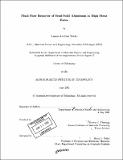| dc.contributor.advisor | Merton C. Flemings. | en_US |
| dc.contributor.author | Yurko, James Andrew, 1975- | en_US |
| dc.contributor.other | Massachusetts Institute of Technology. Dept. of Materials Science and Engineering. | en_US |
| dc.date.accessioned | 2005-08-23T20:17:17Z | |
| dc.date.available | 2005-08-23T20:17:17Z | |
| dc.date.issued | 2001 | en_US |
| dc.identifier.uri | http://hdl.handle.net/1721.1/8451 | |
| dc.description | Thesis (Ph.D.)--Massachusetts Institute of Technology, Dept. of Materials Science and Engineering, 2001. | en_US |
| dc.description | "June 2001." | en_US |
| dc.description | Includes bibliographical references (leaves 119-127). | en_US |
| dc.description.abstract | The rheological behavior and microstructure of semi-solid aluminum alloys were studied using a novel apparatus, the Drop Forge Viscometer (DFV). The viscometer determines force from the curvature of displacement data allowing calculations of viscosities at shear rates in excess of 1000 s-1. Alternatively, the DFV can be operated like a conventional parallel-plate compression viscometer, attaining shear rates as low as 10-5 s-1. Durations of an experiment range between approximately 5 ms and 24 hours. Most rapid compression tests resulted in periods of first rapidly increasing shear rate followed by rapidly decreasing shear rate. Viscosity during the increasing shear rate period decreased by 1-2 orders of magnitude. The viscosity during the decreasing shear rate was an order of magnitude smaller (relative to another experiment) when it achieved a 75% greater maximum shear rate. The DFV was used to calculate viscosity as a function of shear rate for Al-Si and Al-Cu alloys that were rheocast with the commercial SIMA and MHD processes, as well as the recently developed MIT method. Experiments were conducted between fractions solid of 0.44 and 0.67. Viscosity of A357 produced by the three processing routes all had similar viscosities, ranging from 300 Pas at 120 s-1 to 2.2 Pas at 1500 s-1. The final height of compressed Al-Cu was always greater than Al-Si for a given set of experimental conditions. Segregation was not observed in rapid compression experiments shorter than 10 ms, either visually or with EDS characterization. At low compression velocities, segregation was observed and increased with the amount of strain. | en_US |
| dc.description.statementofresponsibility | by James Andrew Yurko. | en_US |
| dc.format.extent | 127 leaves | en_US |
| dc.format.extent | 9903812 bytes | |
| dc.format.extent | 9903572 bytes | |
| dc.format.mimetype | application/pdf | |
| dc.format.mimetype | application/pdf | |
| dc.language.iso | eng | en_US |
| dc.publisher | Massachusetts Institute of Technology | en_US |
| dc.rights | M.I.T. theses are protected by copyright. They may be viewed from this source for any purpose, but reproduction or distribution in any format is prohibited without written permission. See provided URL for inquiries about permission. | en_US |
| dc.rights.uri | http://dspace.mit.edu/handle/1721.1/7582 | |
| dc.subject | Materials Science and Engineering. | en_US |
| dc.title | Fluid flow behavior of semi-solid aluminum at high shear rates | en_US |
| dc.type | Thesis | en_US |
| dc.description.degree | Ph.D. | en_US |
| dc.contributor.department | Massachusetts Institute of Technology. Department of Materials Science and Engineering | |
| dc.identifier.oclc | 50673710 | en_US |
